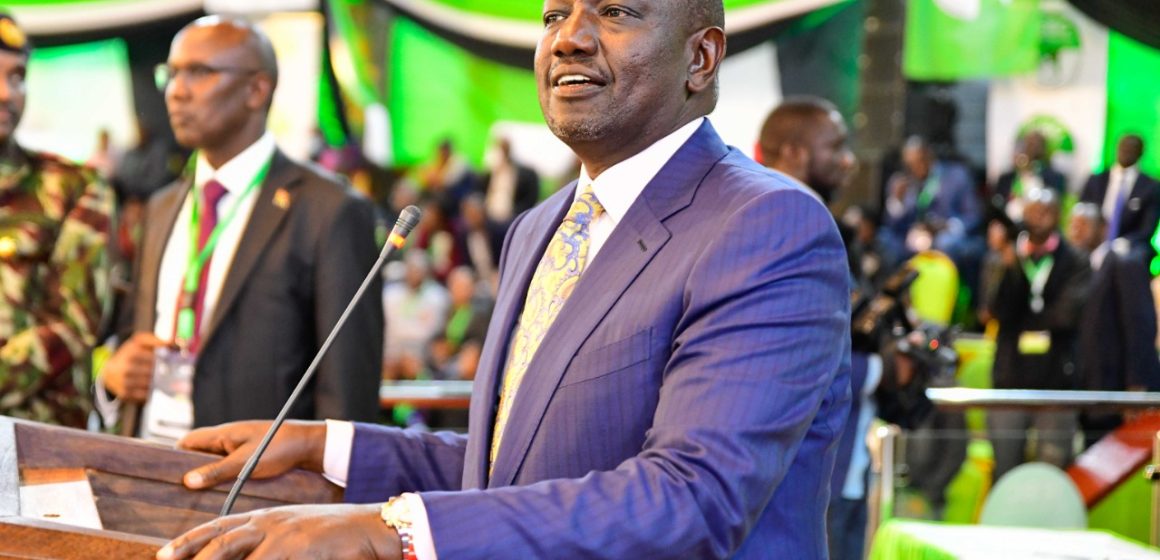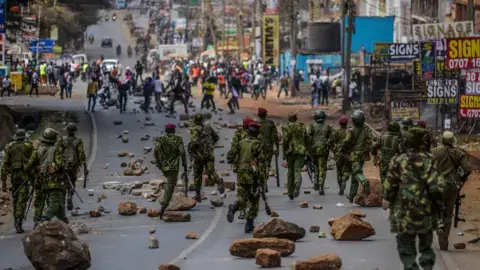|
LISTEN TO THIS THE AFRICANA VOICE ARTICLE NOW
Getting your Trinity Audio player ready...
|
Independent Electoral and Boundaries Commission (IEBC) Chairman Wafula Chebukati has declared Deputy President William Samoei Ruto Kenya’s President-elect in a hotly contested election.
Deputy President William Ruto will go down in Kenyan history as one of the most ambitious yet successful politician in Kenya’s history.
Born on December 21, 1966, in Sugoi, Uasin Gishu County, to Mzee Daniel Cheruiyot and Mama Sarah Cheruiyot, his political journey is a tale of a daring go-getter who settles for nothing less than what he has set his eyes.
He attended Kamagut Primary School before proceeding to Wareng Secondary School and later Kapsabet Boys High School for his A level. Ruto then joined the University of Nairobi, where he studied Botany and Zoology, graduating with a Bachelor of Science in 1990. He enrolled for a Master of Science Degree at the same University graduating in 2011. Soon after, he scaled education heights by registering for a Ph.D. in the same University, earning his doctorate in 2018.
He is married to Racheal Ruto, and they have six children.
Ruto joined politics in the early 90s when he met the late President Daniel Moi while he was doing evangelism work. Moi recruited him in 1992 to be one of the founders and key members of the youth for KANU 1992, popularly known as YK92, a group that was used to campaign for Moi during the advent of multi-party elections in the country.
After successfully campaigning for Moi, he set his eyes on the Eldoret North Constituency seat. He won the seat in 1997 on a KANU ticket and would be the area MP for three terms after winning the 2002 and 2007 elections.
He served as Assistant Minister in the Office of the President between 1998 and 2002 before being promoted to Minister for Home Affairs. He also served as Minister for Agriculture and Higher Education during the era of the late President Mwai Kibaki.
However, his stint as Minister of Agriculture was not free of controversy, having been implicated in the maize scandal. The accusation led to the fallout between him and former Prime Minister Raila and his main rival, who was once a very close ally in the just concluded election.
Dr. Ruto’s first attempt to run for president was in 2007, when he and Raila were both eyeing the Orange Democratic Movement (ODM) presidential ticket but lost to the latter. Ruto conceded defeat and was one of the critical people in Raila’s campaign team.
Ruto set his eyes on the country’s top seat again in 2013 when he decided to support President Uhuru Kenyatta with the promise that he would return the favor after his two terms ended. However, the 2018 handshake between President Kenyatta and Raila seemingly irked him. Ruto’s decision to go against President Kenyatta and start early campaigns saw the two who were once bosom friends drift apart.
DP Ruto would later claim that President Kenyatta snatched his duties as he continued campaigning in Mt Kenya. They could no longer hide their differences by engaging in public spats as Ruto portrayed himself as a victim while claiming that the head of state was continuously mistreating him. It later became evident their differences were irreconcilable after President Kenyatta publicly announced that he was backing his former rival Raila for the presidency.
Ruto remained defiant and would continue campaigning in churches and donating huge amounts of money. However, his church donations raised eyebrows as many questioned how a self-proclaimed ‘hustler’ had acquired so much wealth.
In campaigns that saw him try to outrun one of Kenya’s most loved politicians Odinga, Ruto caught the attention of the youth by framing this year’s election as a contest between hustlers and dynasties. Through his bottom-up political mantra, he angled himself as the savior of the downtrodden.
At 55, William Ruto considers himself young and has promised to give youths opportunities to improve their lives. According to Ruto, his bottom-up economic model will benefit millions of Kenyans comprising mama mbogas, bodaboda riders, and mkokoteni pushers, among others in the lower class of the Kenyan masses.
Ruto has been giving out wheelbarrows, handcarts, and water tanks to unemployed youths as a way of empowering them.
His story of how he went to school barefoot, only getting his first pair of shoes at age 15, and how he sold chicken by the roadside as a youth in Rift Valley has resonated with most Kenyans who come from humble backgrounds.
He has been linked to corruption scandals in government since he took office and has also been implicated in several cases of land grabbing, but he has denied any wrongdoing.
THE INTERNATIONAL CRIMINAL COURT
In 2011 Ruto and President Uhuru Kenyatta were indicted by the International Criminal Court for the incitement that saw more than 1200 people killed and 600,000 displaced from their homes.
After winning the 2013 election, their plans to outsmart the ICC worked perfectly as the two used their powers to challenge ICC after taking office.
The 2013 Kenyatta and Ruto union and the presidential ticket was a marriage of convenience that shocked many Kenyans as the two had been on opposite sides in the 2007 election. The only thing they had in common at the time was the International Criminal Court (ICC) criminal charges for violation of human rights at the Hague, Netherlands, after they had been accused of organizing attacks that led to the 2007-2008 post-election violence.
For instance, Uhuru warned the ICC that the constitution of Kenya prevented the two leaders from being out of the country simultaneously, forcing the judges to hear their cases alternately.
They also used Kenya’s parliament to pass a motion to withdraw Kenya from the ICC, but it hit a snag when they failed to get other countries to back them up.
The UhuRuto duo argued their merger was an example of reconciliation, but their opponents saw it as a cynical attempt to avoid justice. Ruto’s charges were dropped in April 2016 due to a lack of evidence. The case has continued to haunt him with looming threats ICC could reopen the case.
His manifesto is anchored on six key pillars of agriculture and food security, small and medium enterprise financing, housing, health access, information, communication technology, creative economy, environment, and climate change.
Ruto has promised to invest Ksh500bn ($4.2bn) toward agriculture and the informal sector to create jobs for women and youths. He has also promised to ensure that Kenya is self-sufficient in food production by making all the needed resources available and ensuring access to loans by investing at least Ksh250bn ($2bn) in the agricultural sector.
Ruto has also vowed to ensure the two-third gender rule in elective and appointive positions in the public sector is achieved, and 50 percent of cabinet slots will be allocated to women, an idea that Kenyan women happily received.
Deputy President Ruto’s manifesto comes with a trail of unfulfilled promises he made in 2013 and 2017. Nonetheless, he insists that he was stripped of power by President Kenyatta when they fell apart.
Unlike other top politicians, Ruto prides himself on being a son of a hustler and rising through the ranks to be where he is, the second in command. Ruto owns vast parcels of land across the country, which also brought him a lot of tribulations.
From being accused of grabbing school property to stealing poor people’s land on April 12, 2022, Kenya Kwanza Political Coalition endorsed Ruto as its presidential candidate for the 2022 general election.
As President-elect, Ruto now awaits to be sworn in as the 5th President of Kenya and commander in chief. But before he ascends to the office, he’s likely to face court challenges from Odinga’s camp, who have argued the election was rigged.
Odinga’s case is strengthened by four commissioners who have objected to declaring Ruto the winner of the hotly contested election.






























LEAVE A COMMENT
You must be logged in to post a comment.